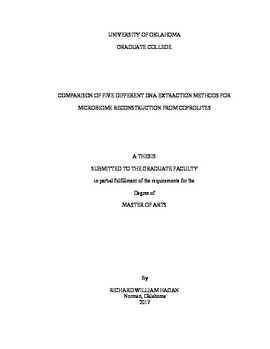| dc.contributor.advisor | Warinner, Christina | |
| dc.contributor.author | Hagan, Richard | |
| dc.date.accessioned | 2017-05-30T14:24:56Z | |
| dc.date.available | 2017-05-30T14:24:56Z | |
| dc.date.issued | 2017-05 | |
| dc.identifier.uri | https://hdl.handle.net/11244/50915 | |
| dc.description.abstract | The human microbiome has become an intense area of research over the past fifteen years due to its importance for understanding human health and disease. The revolution in Next-Generation Sequencing (NGS) techniques has made microbiome science accessible to many types of researchers, including biomolecular archaeologists, amongst whom interest in the ancestral state of the human microbiome is increasing. Two archaeological materials — dental calculus and coprolites — have been shown to harbor ancient microbial DNA that can be extracted, purified, and sequenced to reconstruct the oral and gut microbiomes of past peoples. While systematic experiments have improved upon techniques for the extraction of ancient DNA from dental calculus, comparable work has not been performed with coprolites. The goal of this study was to compare ancient DNA extraction and purification procedures using human coprolites that have previously yielded ancient DNA. Five DNA extraction methods were applied to the three coprolites, including a standard protocol utilizing a commercial fecal DNA isolation kit and four protocols progressively optimized for the recovery of ancient DNA. Each coprolite was subsampled to allow for the testing of all five extraction methods in duplicate, for a total of 30 extractions. The concentration of all DNA extracts was measured, and extracts were then converted into Next-Generation shotgun sequencing libraries. The libraries were pooled and sequenced, and a series of metataxonomic and statistical analyses were performed on the resultant data to test for differential impacts between extraction and purification chemistries. Methods designed specifically for ancient DNA recovered significantly more DNA than the tested
commercial kit; however, no significant shift in the microbial community structure of the samples was observed between extraction and purification strategies. | en_US |
| dc.subject | Anthropology, microbiomes, coprolites, aDNA | en_US |
| dc.title | COMPARISON OF FIVE DIFFERENT DNA EXTRACTION METHODS FOR MICROBIOME RECONSTRUCTION FROM COPROLITES | en_US |
| dc.contributor.committeeMember | Lewis, Cecil M. | |
| dc.contributor.committeeMember | Sankaranarayanan, Krithivasan | |
| dc.date.manuscript | 2017 | |
| dc.thesis.degree | Master of Arts | en_US |
| ou.group | College of Arts and Sciences::Department of Anthropology | en_US |
| shareok.nativefileaccess | restricted | en_US |
